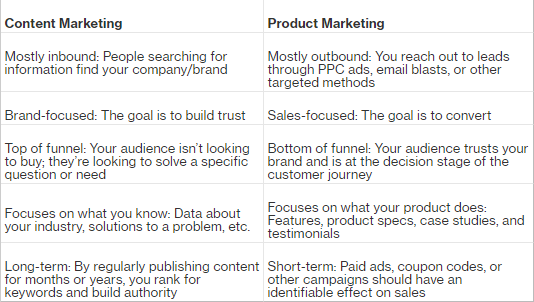Product marketing vs. content marketing: Before, at, and after a launch

.png)

.png)
So you built something cool. It looks great, solves a prevalent problem, and comes with a competitive price tag. Time to tell the whole world, right?
Not so fast. If you don’t understand how and when product marketing should be used, you may be setting yourself (and your sales team) up for failure. A new launch shouldn’t be the trigger for a switch from content marketing to product marketing. A strong product marketing strategy starts before launch and coexists with your content marketing efforts.
Content and product marketing work better together in almost every situation. You can’t substitute one for another or try to combine them because they work in different ways. While the intent of content marketing is to introduce prospective leads to your brand and build brand authority, product marketing should make consumers want your product. Here’s a head-to-head of content marketing vs. product marketing:

Let’s dig into the assets you need for a successful product marketing initiative now that you know more about its purpose. Your product marketing campaign should position your product, share its value proposition, and highlight key features and capabilities using:
Your needs may vary depending on what you’re selling: For some products, some of these assets don’t make sense. This list looks very different from a typical content marketing strategy, and your product marketing campaign should be likewise distinct. Whether you’re before, at, or after launch, here are the things you can only achieve with product marketing.
While content marketing reaches audiences by meeting them at their point of need, product marketing has the more difficult job of convincing leads they need what you’re selling. This requires a more in-depth understanding of consumer needs than any content strategy.
Content marketing research mainly involves keeping up on industry conversations and finding popular keywords and questions to answer. Product marketing requires you to go a step deeper. Your target audience is more than the sum of their Google searches. If you want someone to use your product, you need to understand their workflow, needs, and pain points. This might mean creating personas and/or scheduling interviews to get to know your potential customers better.
The information you gather should guide you as you create a product positioning statement. A successful positioning statement can provide framing for future product marketing campaigns. If you’re struggling to write one, ask yourself:
Getting your core messaging down is only one part of planning a successful product launch, but it’s essential to attracting new customers and closing sales. No blog post, no matter how good, can make up for a lack of strong messaging.
As soon as your product is available for purchase, your team should be ready to raise its profile. Content marketing is a long game where you sometimes wait for months to show up at the top of a search engine results page. Product marketing, by contrast, is after quick results. Targeted ads, social media promotion, and direct outreach by salespeople are favored tactics to build launch buzz.
Your marketing team can set your sales team up to succeed by helping with outreach. Start by identifying leads gathered through your existing content marketing efforts. Loyal readers who have signed up for a newsletter or followed you on social media are in your target market and interested in hearing more from you. This means your sales team can make a warm intro rather than a cold call.
Your salespeople will need more than content to help them nurture and sell leads. They’re not here to answer questions someone can Google. They’re here to help a customer understand how your product is the best option for them. Sales enablement assets like product spec sheets and sales decks include concrete reasons to buy. Your product positioning statement will help them communicate this information successfully.
The more you can target people who already know and trust your brand, the better the response will be. Having that goodwill on your side can make all the difference if your product is a big investment or commitment.
Because high-quality content can build this sort of trust, many marketers create product sales materials that look like and are distributed in the same way as content marketing materials. However, the return on such efforts is low at best—and your attempts may even backfire. Leads you’ve gathered through content marketing are willing to listen because you’ve already taken the time to prove your value and expertise. Attempts to land new leads through a blog post that’s a thinly veiled “buy our product” announcement don’t help you build trust. Readers will go elsewhere to find an answer that doesn’t require investing in a new and (to them) unproven product.
Product marketing doesn’t end when the prospect makes a purchase. It’s your job to keep them informed and engaged so they stay a customer. While this phase of product marketing may seem most like content marketing, it’s still unique in its audience (paying customers) and scope (issues that directly affect your product). You’ll be creating a different type of content than you would if you were focusing only on SEO.
The first after-purchase phase of product marketing is the onboarding process. Craft a series of onboarding emails and set up in-app messaging to introduce users to the right feature at the right time. Showing your customers the value in your product reassures them they made the right decision in purchasing it.
Once a customer has figured out your product and successfully integrated it into their workflow, you can slow the rate of communications, but don’t drop them off entirely. New feature releases and product updates give you a great excuse to reach out to your users. Sharing new value and showing your company is listening to customer feedback are great ways to reinforce trust.
Any chance you have to collect feedback is a chance to strengthen your product marketing efforts. Customer surveys can help you identify new messaging angles and identify areas where your onboarding process needs work. Testimonials from happy customers and case studies provide excellent social proof to help nurture leads. On the flip side, you may spot customer drop-off. Product marketing efforts are sometimes necessary to bring an unhappy customer back. Special offers, individual outreach, or messages that highlight features specific to a user’s needs can help reignite a user’s interest and re-win their loyalty.
With content marketing speaking to top-of-funnel audiences and product marketing aimed toward bottom-of-funnel ones, using both approaches together is typically the best plan. Just make sure your top-of-the-funnel content isn’t too heavy on the sales, and your bottom-of-the-funnel campaigns are geared toward helping audiences understand why your product is the right fit for them.
In this way, content and product marketing materials work just like any other assets you’d create for an audience at a specific part of the funnel. Just remember where each approach sits on the funnel, and you’ll know what to emphasize in each type of campaign. After all, having the right messaging isn’t enough—you also have to share it at the right time.